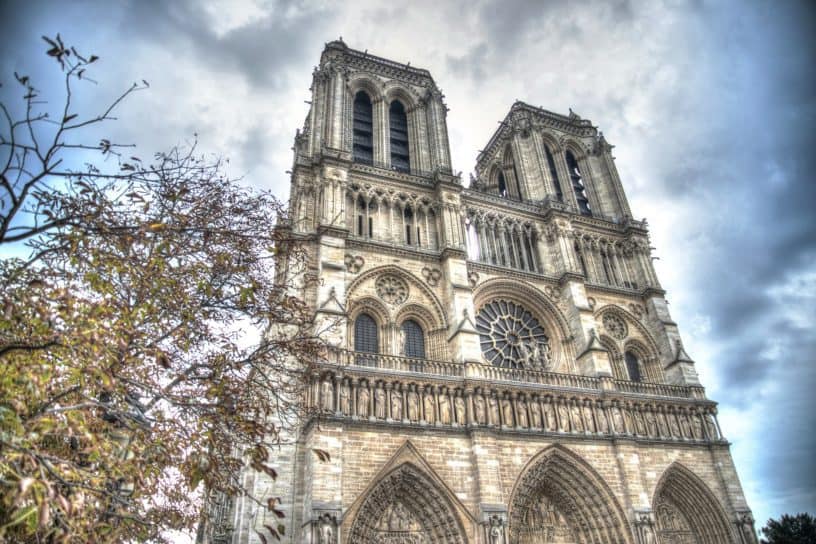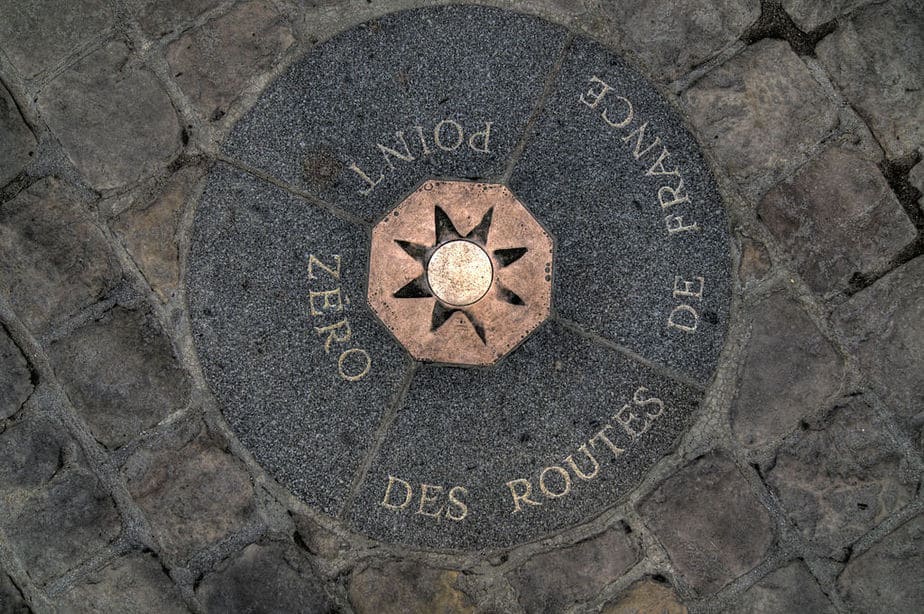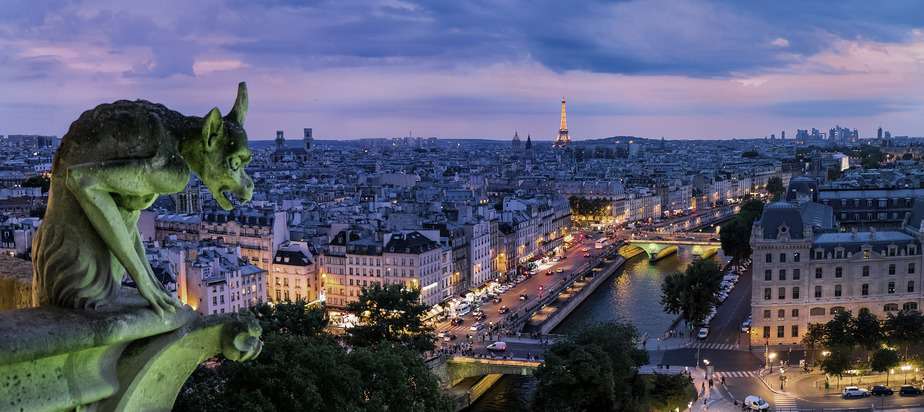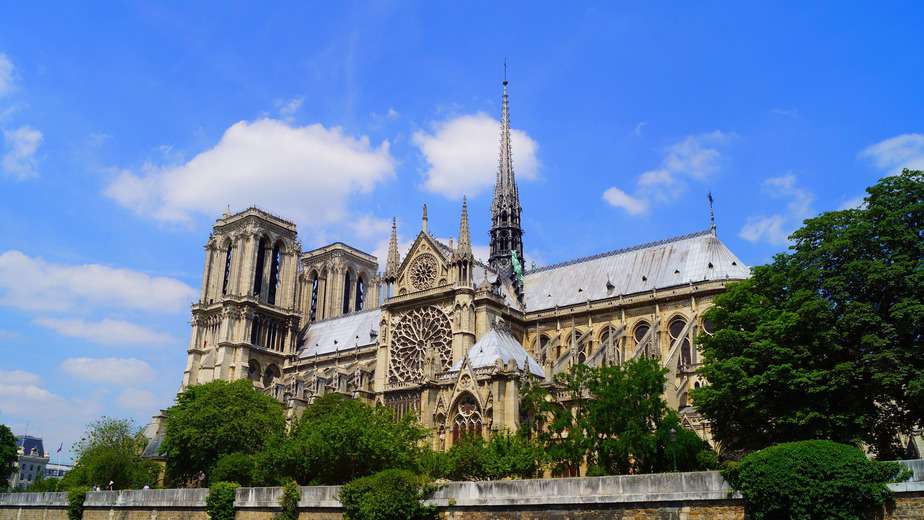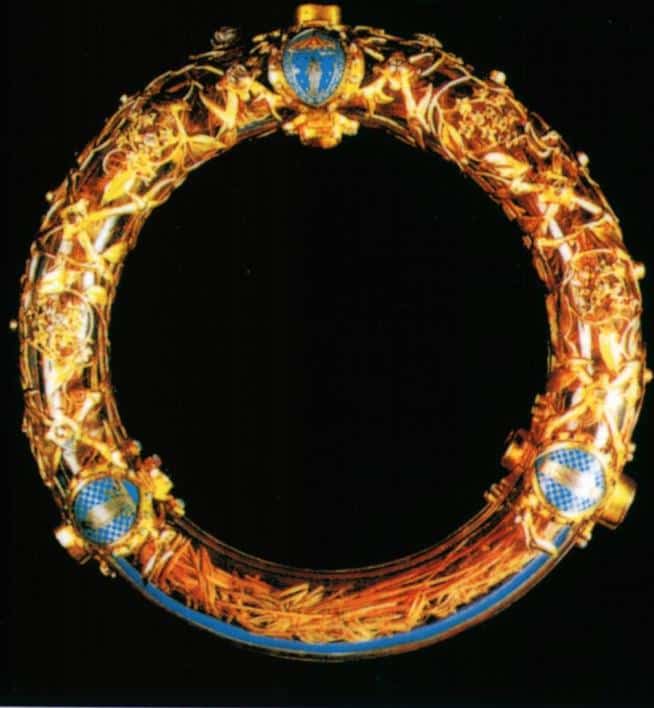15 facts about Notre-Dame Cathedral
UPDATE: our guestbook for Notre Dame
Originally Published by Nicolas in August 2021 and updated by Ruth in August 2022
On April 15th 2019, the spire and the oak room collapsed after a spectacular fire that destroyed a large part of Notre Dame. This catastrophic fire burned for several hours and it took more than 400 firemen to contain the blaze. A very sad day for France.
However, Notre Dame is not dead and a plan to renovate our national symbol has already been announced by the French government. Only two days after this tragic event, more than €800 million were already raised to rebuild the Church.
OUR GUESTBOOK: Tell us something about Notre Dame
What happened to Notre-Dame during the fire?
Well, as you probably saw tragedy struck Notre-Dame cathedral April 15th, 2019 when a massive fire broke out just after 6PM. While the exact cause of the fire is still unknown, the firefighters and authorities estimate it was an accident. What we do know, is that during the time the cathedral caught fire, it was under construction with massive scaffoldings encasing the spire and posterior. Parisian firefighters took the risk of a potential fire here very seriously, and had weekly training drills in case of such an event. Thankfully they were very well prepared and managed to save most of the cathedral.
At the first sign of flames, around 400 firefighters were dispatched and were able to evacuate everyone on the Ile de la Cité as well as save the majority of the precious relics inside.
Sadly, there was quite a bit of damage, as the fire blazed for several hours before being extinguished. At exactly 7:50 PM, the cathedral’s famous spire fell and succumbed to the flames – tears were visible on everyone’s face as the city watched their most beloved symbol burn. But luckily, despite the damage to the rooftop and spire, the majority of the Cathedral including the 13th century stained glass windows as well as the stone towers, remained intact.
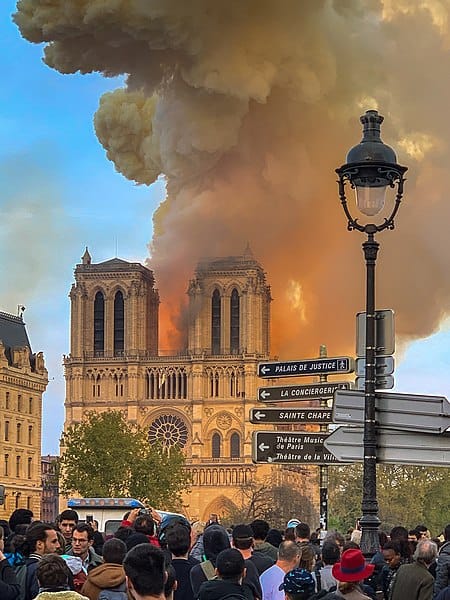
Milliped, via Wikimedia Commons
Towering at a height of 69 meters (226 feet), the Notre-Dame Cathedral – fully called Notre-Dame de Paris (Our Lady of Paris) in French – remains today one of the most important landmarks of the French Capital.
If millions of visitors walk through its portals every year, only a few take the time to care about the details.
Before I list off the 15 interesting facts about the Notre-Dame de Paris, it’s important to know a bit of background about the cathedral. So what exactly is the Notre-Dame and why is it the most popular cathedrals in the world?
The Notre-Dame sits at the eastern end of the Île de la Cité and was actually built on top of the ruins of two other churches. Besides being the most famous Gothic cathedral of the Middle Ages, it is most notable for its size and architectural style. Its beginnings took place more than 850 years ago, in the heart of a much smaller Paris. Construction began in 1163, during the reign of King Louis VII, and was completed in 1345. Last year wasn’t the first time the cathedral was damaged…
In the 1790’s during the French Revolution, the Notre-Dame was damaged as well as neglected. This even inspired Victor Hugo’s “The Hunchback of Notre Dame”, novel, telling us about the building’s deteriorating. Some really interesting historical events took place at the Cathedral Notre Dame. For one, Henry VI was coronated as king of France inside the cathedral in 1431, and in 1801 Napoleon was crowned emperor. Another interesting yet creepy background fact- the spire that collapsed is creepier than many would think. It actually contained teeth, bones, and hair of the patron saints of Paris- St. Denis and St. Genevieve. The relics were placed there to protect the Notre Dame.
Furthermore, this wasn’t the first time the cathedral burned. Fire struck during the 13th century…
Now onto the list of interesting facts. Here are fifteen interesting facts about this religious and architectural masterpiece in Paris.
1. The Cathedral is the most visited monument in Paris
France is the most visited country in the world. Surprisingly enough, its most visited monument is not the Eiffel Tower.
If Disneyland Paris is the number one tourist destination in France, the Notre-Dame Cathedral is the most visited monument within the Paris city limits.
More than 13 million visitors pass through the grand gate of Notre-Dame every year. This means the Cathedral welcomes around 35 thousand visitors a day! In France, 99% of towns have a smaller population than this!
If you wish to avoid the crowds, I recommend you arrive early at Notre-Dame. The gates open at 7:45AM but most visitors arrive a bit later, so take advantage of the early hours to visit the grandiose monument without thousands of people around.
Read next: Top Walks in Paris
2. The Cathedral is built on a sacred location
Notre-Dame de Paris is built on the Île de la Cité (City Island) in the very center of Paris. It is quite hard to imagine the Île de la Cité without the Notre-Dame Cathedral. Standing here since the 12th century, the Gothic masterpiece seems to have been here forever.
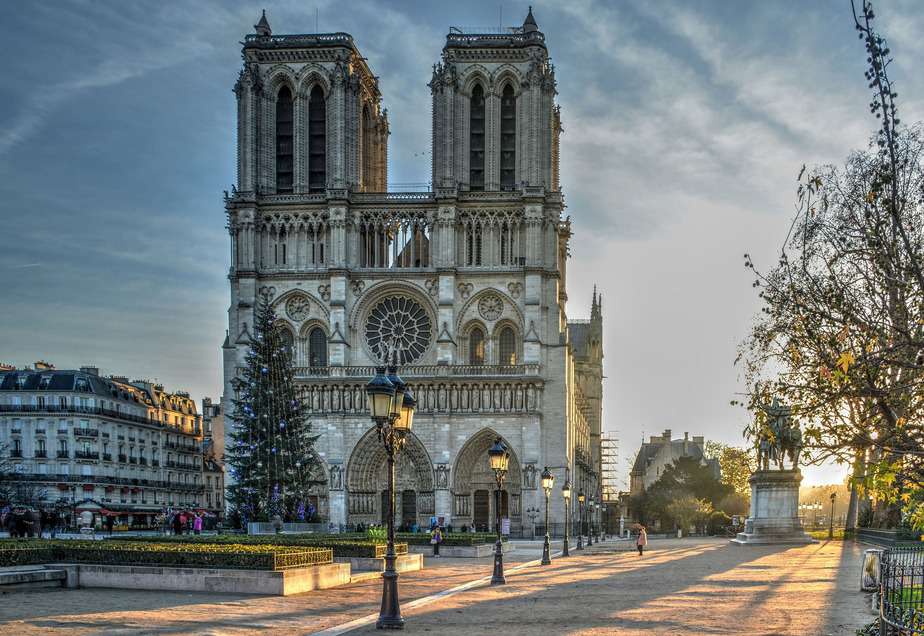
Notre-Dame was built on a location dedicated to religions since the Roman Ages – Source : Pixabay.com CC0
However, the Île de la Cité was here long before the Cathedral. After the Gauls were defeated by the Romans in the Battle of Lutetia (52 BC), the new Gallo-Roman city of Lutetia settled and developed on the Left-Bank and on the Île de la Cité. The common and popular neighborhoods were located on the Left-Bank along current Rue Saint-Jacques.
Since the origins, the Île de la Cité was divided in two parts: the westernmost half was dedicated to the matters of the City and was home to the Palace were the rulers could reside during their visits in Lutetia; the easternmost half, on the other hand, was dedicated to worship and hosted several altars (at least, if not temples – this remains unclear).
This island division, with one half dedicated to justice and ruling and the other one dedicated to religion – survived through times. During the Middle-Ages, the Roman Palace was replaced by the Royal Palace – which later became the Palace of Justice and the Conciergerie – and the altars were replaced by successive catholic churches.
Notre-Dame was later built on the remains of these churches.
3. The Cathedral is a measurement reference : the overlooked “Point Zéro”
If you already stood in line in front of Notre-Dame, chances are you looked at the sculpted façade, or towards the Seine riverbanks… but you probably didn’t look down to the ground very much, did you?… Well, if you didn’t, this was a mistake, because you missed an important detail: the official reference point representing Paris.
Indeed, on the square in front of the church, a much overlook tiny plate, engraved with a compass, and known as “point zéro des routes de France” (Point Zero of French Roads), indicates where all distances to and from Paris are measured from.
4. The Cathedral’s bells have had a life of their own
Like often with churches, the bells of Notre-Dame bear names. In Notre-Dame, they are called Marie, Emmanuel, Gabriel, Anne-Geneviève, Denis, Marcel, Etienne, Benoît-Joseph, Maurice, and Jean-Marie, for the main ones.
But what is more interesting is the tumultuous lives of these bells. If Quasimodo, the famous hunchback created by Victor Hugo to ring the bells of the great Cathedral was an invention, the two-to-three ton pieces of bronze have had a life on their own. The bells we now hear are no longer the ones installed upon completion of the Cathedral, six-hundred years ago.
Indeed, after the French Revolution, in 1791, most bells were taken down from Notre-Dame and melted to make cannon balls. New bells were only installed during the mid-19th century and contributed to a recognizable chime which sounded in the skies of the French Capital for 150 years. In 2013, to celebrate the 850th anniversary of Notre-Dame, the bells were replaced in a much mediatized ceremony and the chimes renewed.
5. The Cathedral’s chimeras are not so-Medieval
A typical element of Gothic art, chimeras and gargoyles are well represented on the walls of Notre-Dame. Gargoyles are hollow statues located at strategic locations to ensure water drainage. Chimeras are purely decorative.
On the towers of Notre-Dame, famous chimeras allow tourists to take well known perspective pictures with the tower chimeras in the foreground and Paris in the background.
People often think that these chimeras are representative of the medieval style of the Cathedral. However, the decorative chimeras of the towers panorama are not medieval at all!
First of all, almost the entirety of gargoyles of the Cathedral have been replaced since de Middle-Ages : indeed, gargoyles in particular, due to their function, are not designed to last long. Most have to be replaced every century or 150 years.
Most chimeras have also been replaced. The most famous ones, in the Galerie des Chimères on the towers have simply been added during the renovations performed by Viollet-le-Duc in the mid-19th century.
6. The Cathedral was saved by Quasimodo
After the French Revolution, Notre-Dame de Paris was much damaged. Some statues had been destroyed and the bells had mostly been melted.
It entered the 19th century in a much degraded state, and almost fell into oblivion, being used as a storage place instead of a religious one. In 1804, however, Napoleon crowned himself the Emperor of the French in the Cathedral, propelling it back onto the front pages.
In 1831, Victor Hugo’s masterpiece, the Hunchback of Notre-Dame, set in mid-15th century Paris with Notre-Dame de Paris as its central location, brought an unprecedented fame to the long-forgotten church. Popular outcries to preserve it, and ministerial programs to preserve it lead to massive renovations directed by Viollet-le-Duc in the mid-19th century, thus saving this jewel of Gothic art.
7. The Cathedral is home to a Forest
Notre-Dame de Paris measures 127 meters (length) by 48 meters (width) and the main nave is 43 meter-high under the roof.
With such dimensions, it may come as surprising that the roof structure is entirely made of wood, dating back from the 12th century. The wood-timber frame is made of more than 1300 trees, each beam being made from one tree.
The roof structure is commonly nicknamed “the Forest” due to its massive dimensions!
8. The Cathedral was a place of beheading
Not a real beheading though. During the Revolution, the people was so disgusted by monarchy that they even started to take down every symbol of royalty on the streets of Paris.
On the main façade of Notre-Dame, the revolutionaries took off the heads of twenty eight statues in a gallery, thinking they were statues of French kings. However, they were mistaken, for these statues were actually representations of the kings of Judah.
The statues are still missing their heads, but twenty-one of them have been found and can be observed in the Musée du Moyen-Âge de Cluny (Middle-Ages Museum of Cluny) on the Left-Bank.
9. The Cathedral follows the Golden Ratio
In architecture, the golden ratio is visible in any shape composed by a square and a rectangle whose combined dimensions roughly correspond to a 1:1.61 ratio. This ratio is known to be a dimension of perfection in art. In architecture, some of the most appreciated and acclaimed buildings follow this ratio, such as the Parthenon in Athens, or the Taj Mahal in Agra.
The western façade of Notre-Dame is clearly composed according to this ratio. The height of the cathedral divided by its width roughly equals to 1.61, the total height is roughly 1.61 times the height of the first two floors, the total width(central section + two towers) is roughly 1.61 the width of one tower plus the central section…
Many other decorative details follow the golden ratio.
10. The Cathedral is home to the Holy Crown
At last, Notre-Dame is home to a priceless treasure among which are the Holy Crown worn by the Christ, a piece of the Cross, and a nail. If the rest of the treasure can be admired year round, you may see the Holy Relics every first Friday of the month during the dedicated worship ceremonies, as well as for Lent and Good Fridays.
11. The Cathedral’s foundation was once a pagan city
Notre Dame Cathedral was built on the ruins of a once pagan city. Built where the Gallo-Roman city of Lutetia once stood, the foundations of Notre Dame changed hands a few times before construction of the famous cathedral began.
It started as a temple to Jupiter before being transformed into a Romanesque church. Ultimately, the old structure was taken down and its foundation (along with a few of its sculptures) was reused in the construction of Notre Dame Cathedral.
12. The Cathedral inspired some songs
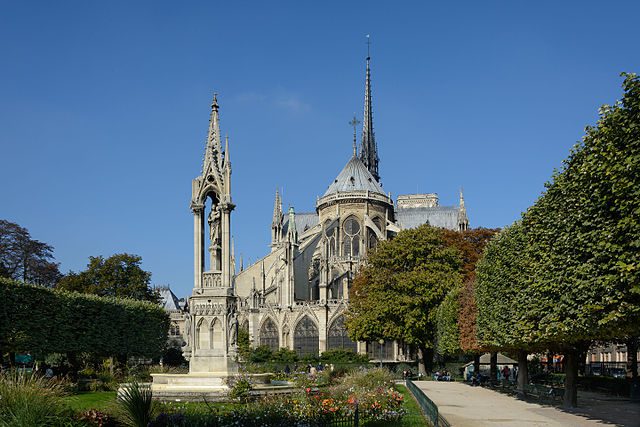
Paris Notre-Dame East View by Uoaei1 – Wikimedia Commons
French singing icon, Édith Piaf was just as inspired by the grand Notre Dame Cathedral as Victor Hugo. Her song, appropriately named “Notre-Dame de Paris”, was one in a long line of famous songs she wrote and performed throughout her life.
“Notre-Dame de Paris” talks about the beauty of the cathedral, the hard work that went into its creation, its long history, and its future as a Parisian icon. In many ways, she seems to sing about the cathedral as a metaphor for herself; both come with a complex history as well as a beautiful future.
13. A rooster protects a piece of Jesus Christ’s crown of thorns at the Cathedral
Gargoyles, a literary history, and popular portrayals aside, one of Notre Dame Cathedral’s most unique features is the rooster sitting atop its tallest spire.
At first glance, this bird probably seems out of place, but it’s actually a sort of “spiritual lightning rod”, meant to protect worshipers inside the cathedral from harm.
14. A fire destroyed the iconic spire and roof of the cathedral in 2019
One element of the church, the so-called “flèche” or spire located over the transept, was even higher. Even though the original spire was completed in the 13th century as well, it was removed in 1786 and rebuilt in oak covered with lead in the late 19th century.
This magnificent Gothic element of the church originally reached a height of 91.44 meters (300.0 feet) but was unfortunately destroyed during the fire that emerged in April 2019, along with large parts of the roof.
15. The Cathedral is 856 years old

Notre-Dame de Paris by P e z i – Wikimedia Commons
The Cathedral was built in the middle ages around 1160. This speaks to its long-standing history and why it is so impressive it was still in such great shape before the fire.
The Cathedral is around 856 years old and it has stood the test of time as it has survived war after war. It is slightly ironic the fire happened now, in a time of peace when the French Revolution and both World Wars left it unscathed. It became a staple piece during this time in the art of gothic architecture, with its tall spire and vaulted ceilings.
Renovation Plans: What’s next for Notre-Dame?
As of December 2020, over €1 billion has been raised for the renovations of Notre-Dame, which French President Emmanuel Macron expects to be completed by 2024. Though while France certainly hopes the Cathedral will be completed in time for the 2024 Olympic Games (which will be hosted in Paris), many architects estimate the construction could carry on much longer. Some saying up to forty years. Hopefully it will be sooner rather than later, but it’s a very complicated project since Notre-Dame is so old.
You can still see the Notre Dame (From the outside)!
That’s right, despite the interior of the Cathedral being closed for renovations, it’s still possible to see some of the majesty of Notre-Dame from outside. And you can even join our guided walking tour of Notre-Dame and the Latin Quarter. Our local guides will tell you all about the history of the cathedral, the stories behind the gargoyles, and give you plenty of insider tips to make the most of your visit to Paris.
Where is the Notre Dame located?
The landmark is located on the Île de la Cité in the 4th arrondissement of Paris. 6 Parvis Notre-Dame – Pl. Jean-Paul II 75004 Paris, France.
Here are the Notre Dame’s closest Paris Metro stations:
St-Michel Notre Dame – RER C Train Line
St-Michel Notre Dame – RER B Train Line
Cité – Line 4
Guestbook: share your memories with us
After the terrible blaze that devastated Notre Dame, we’ve decided to open a guestbook for everyone to comemorate Notre Dame.
Here you can share your thoughts about Notre-Dame cathedral. If you have a picture, we will be pleased to publish it.
Read our guestbook
A privilege
In August 2018, I had the privilege of seeing this masterpiece firsthand with my daughter by my side. Notre Dame was a sight of wonder and will always be special to me as a Catholic. I support the people of Paris and pray that one day the Church will be able to stand tall again.
Thank you!

Thank you for these wonderful facts about this beautiful masterpiece. They are especially important now, following the fire. Loved just sitting near the church watching people come and go
Masterpiece
What does it mean to me, a holy place a masterpiece of gothic Architecture that was built to honor our blessed Virgin Mary . A place for all Christians to worship.
Our home away from home!

We live right down the street of Notre Dame on the Island and saw this devastating event take place! We walk by it every day!
Our hearts may be heavy but our minds are resolut to make good from something sad! I took this photo exactly one week prior to the fire! We have 10 more months of a total of 23 months here in Paris!
My most precious memory.

One grey July morning in 2013, I was staying in an apartment opposite Notre Dame. I had awoken earlier than usual that morning and stood at the window and stared at the beautiful Cathedral and the deserted square in front. Without thinking, I dressed quickly and left the apartment, and my sleeping husband, and crossed the bridge. I stood and looked up at the Cathedral and then I saw a man by the side door and walked over to him. Struggling with my pitiful French, I asked him if it would be possible to go inside, although I knew the Cathedral was closed to the public at that hour (7:10am). He opened his arms wide, smiled and told me I was very welcome!
I stepped inside that hushed, stunning Cathedral, devoid of people, and stood transfixed. The beauty, the peace, the magnificence of that hallowed building just overwhelmed me. I tiptoed around, afraid to make any noise (I don’t know why) and craned my neck upwards to admire the windows, the ceiling, the columns; somehow I felt this huge stone building was embracing my very soul. I sat on a chair beside one of the stone columns, unaware of how the time was passing and suddenly realized I was not alone any more; other people were walking quietly into the Cathedral to attend Mass. I did not move. The Priest, who must have been there all the time unbeknownst to me, began the Mass and I closed my eyes and listened to the muffled voices chanting the responses . Finally, I arose and crept out as silently as I could. Outside, blinking in the unaccustomed daylight, I saw that a line of tourists had formed.
My precious moment of solitude was over and I walked slowly and thoughtfully back to the apartment my heart soaring .
I will never forget the morning when I was alone inside that beautiful Cathedral and was overcome by peace, awe, and … sheer happiness.
French student recalls visit
I am a French teacher here in the U.S. and many years ago I brought a group of students to France. One of those students just messaged me to tell me how grateful she was to have seen Notre Dame back then, because of the fire. I hope they can rebuild it and am grateful that it did not completely burn to the ground.
That celestial ship
With no roof and no spire, Notre Dame is now an earthly object, tied down to the ground. And the flying buttresses no longer serve as the knots that keep the celestial ship from floating back to heaven.
The destructions caused by the fire make us see what makes Notre Dame so super-natural.
Let a roof and a spire and the effect-creating disciples return quickly please.
Notre Dame Fire

I think it is sad that it caught on fire. Many people say that it is just a building. However, it is a place where people worship. It is also history made over 850 years ago. I am glad it did not burn down.
Our recent visit to Paris April 2019

Nothing will dampen the beauty and grandeur of this grand dame . The Notre Dame will be restored to its former glory. The project will need the time, the skill and the patience of experts globally to ensure the work is executed to the standard the Notre Dame deserves.
A tragedy.
We spent months planning a trip to Europe, including a week in Paris. This is such a long way from our home in New Zealand. We had booked a skip-the-line tour of Notre Dame, and were devastated when we saw the fire on tv, only about a week before our holiday started. If we can visit Paris again, Notre Dame will be the first place we visit!
Always In Our Hearts
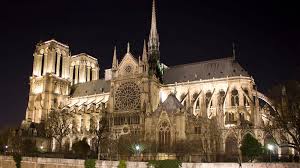
I never truly appreciated this place until I turned on the television one day and saw it burning. I’ve never been to Paris, and it’s likely I never will, but I will always remember it. Even if they rebuild it, it won’t be the same. Always in our hearts.
Notre Dame from a chimera’s POV

On my first visit to Paris, I went to ND on my first full day and walked to the top of the North tower where I took this photo. For the rest of my stay in Paris, I was limping due to straining a hip muscle on the walk up. It was worth it. Magical.
Planning a trip to Paris ? Get ready !
These are Amazon’s best-selling travel products that you may need for coming to Paris.
Bookstore
- The best travel book : Rick Steves – Paris 2023 – Learn more here
- Fodor’s Paris 2024 – Learn more here
Travel Gear
- Venture Pal Lightweight Backpack – Learn more here
- Samsonite Winfield 2 28″ Luggage – Learn more here
- Swig Savvy’s Stainless Steel Insulated Water Bottle – Learn more here
Check Amazon’s best-seller list for the most popular travel accessories. We sometimes read this list just to find out what new travel products people are buying.

 English
English
